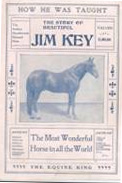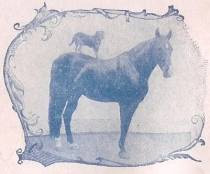|

BEAUTIFUL
Jim Key (1889-1912)
|
|
|
|
Demonstrating
Spelling abilities – 1904 LOUISIANA PURCHASE
EXPOSITION
|
Beautiful
Jim Key Memorial & Burial Place - Shelbyville,
TN
|
 All
but forgotten, save for a few pockets of interest and markers
of obscured hoofprints and footprints, the lost history
of Dr. William Key and his best friend Jim Key began to
resurface in the 1970s when award-winning filmmaker and
great American story hunter David Hoffman acquired an inconspicuous
promotional pamphlet, little suspecting he had come across
treasure begging to be reclaimed. All
but forgotten, save for a few pockets of interest and markers
of obscured hoofprints and footprints, the lost history
of Dr. William Key and his best friend Jim Key began to
resurface in the 1970s when award-winning filmmaker and
great American story hunter David Hoffman acquired an inconspicuous
promotional pamphlet, little suspecting he had come across
treasure begging to be reclaimed.
From
that unassuming pamphlet, David Hoffman and Mim Eichler
Rivas, joining forces, were able to reassemble the story
that leapt onto the public stage in 1897 when, at age eight,
Beautiful Jim Key trail-blazed his way into stardom and
set the standard for animal celebrities forever after.
 From
1897-1906, over nine years of continuous performances, Doc
Key and Jim captivated the nation by demonstrating the “power
of kindness” employed by Bill Key in cultivating Jim’s
inexplicable abilities to read, write, spell, do math, tell
time, sort mail, use a cash register and a telephone, cite
Bible passages, and engage in political debate. From
1897-1906, over nine years of continuous performances, Doc
Key and Jim captivated the nation by demonstrating the “power
of kindness” employed by Bill Key in cultivating Jim’s
inexplicable abilities to read, write, spell, do math, tell
time, sort mail, use a cash register and a telephone, cite
Bible passages, and engage in political debate.
Known
as the “Marvel of the Twentieth Century” and “The
Greatest Crowd Drawer in America,” the two were seen
by an estimated ten million Americans and written about
in every major newspaper. Fans collected his promotional
pamphlets, souvenir buttons, postcards and photos, bought
Beautiful Jim Key pennies, danced the “Beautiful Jim
Key” two-step, wore Jim Key gold pinbacks in their
collars, and competed in Beautiful Jim Key essay contests,
while millions signed up to join and support humane groups
around the country. Two million children joined the Jim
Key Band of Mercy and signed his pledge, “I promise
always to be kind to animals.”
 Bred
for the turf – out of an aging but pure Arabian, Lauretta
Queen of Horses, that once belonged to P.T. Barnum, by Tennessee
Volunteer, an illustrious Hambletonian sire– the colt
was foaled in 1889 in Shelbyville, Tennessee, so sickly
and crippled that his owner, Dr. William Key, hardly expected
the ugly duckling of a scrub-colt to live. Instead of naming
him for a biblical prophet as he had planned, he chose “Jim”
after a wobbly local drunk, but gave him his own last name.
Treating him with his own medicines, the Doc watched as
the misfit colt transformed into a gorgeous mahogany bay. Bred
for the turf – out of an aging but pure Arabian, Lauretta
Queen of Horses, that once belonged to P.T. Barnum, by Tennessee
Volunteer, an illustrious Hambletonian sire– the colt
was foaled in 1889 in Shelbyville, Tennessee, so sickly
and crippled that his owner, Dr. William Key, hardly expected
the ugly duckling of a scrub-colt to live. Instead of naming
him for a biblical prophet as he had planned, he chose “Jim”
after a wobbly local drunk, but gave him his own last name.
Treating him with his own medicines, the Doc watched as
the misfit colt transformed into a gorgeous mahogany bay.
 A
self-trained veterinarian, “Dr.” William Key was
born a slave in 1833. Even as a child Bill was recognized
for having extraordinary horse whispering and animal healing
skills – using only kindness and no force. Educated
by his master, tanner John W. Key, and his master's sons
in Shelbyville, Tenn., Bill later chose to protect the boys
during the Civil War, serving the Rebels in the battles
of Fort Donelson, Stones River, and Shiloh, while also serving
the Yankees and fellow slaves along the Underground Railroad.
Sentenced to hang as a double-agent, he escaped thanks to
his poker-playing genius. After the war, he went back to
Shelbyville, paid off the mortgage on his dead master's
fallen property, and supported his master's heirs for the
rest of their days. A
self-trained veterinarian, “Dr.” William Key was
born a slave in 1833. Even as a child Bill was recognized
for having extraordinary horse whispering and animal healing
skills – using only kindness and no force. Educated
by his master, tanner John W. Key, and his master's sons
in Shelbyville, Tenn., Bill later chose to protect the boys
during the Civil War, serving the Rebels in the battles
of Fort Donelson, Stones River, and Shiloh, while also serving
the Yankees and fellow slaves along the Underground Railroad.
Sentenced to hang as a double-agent, he escaped thanks to
his poker-playing genius. After the war, he went back to
Shelbyville, paid off the mortgage on his dead master's
fallen property, and supported his master's heirs for the
rest of their days.
The
entrepreneurial Dr. Key established a leading veterinary
practice, a racetrack, hotel, restaurant, and made a fortune
in the patent medicine business selling Keystone Liniment
in his traveling medicine shows. He was married to four
notably beautiful, educated women. His third wife, Lucinda
Davis Key, MD, received her medical degree at Howard University,
one of the first black women doctors licensed to practice
in the state of Tennessee. Dr. Key had no children of his
own.
Bill
was already fifty-six years old when the sickly Jim was
foaled. When Jim's dam died, the gangly foal refused to
be separated from his owner and trainer, causing such a
ruckus in the barn that Dr. Key was forced to take the colt
into his home and out on the road with him to sell Keystone
Liniment.
Traveling
and performing with Dr. Key and his medicine show for the
next seven years, Jim became a seasoned thespian. The Doc
began his serious tutelage of Jim on a whim, thinking he
would teach him only one letter of the alphabet, then another,
then the rest. Over seven years, he used kindness, patience
and rewards to teach Jim to read, spell, recognize money,
and do basic arithmetic.
In
1897, Dr. Key was invited to serve on the Negro Committee
at the Tennessee Centennial Exposition in Nashville. Jim
came along, making his debut as an educated horse, and earning
the rapturous praise of President William McKinley –
who declared that Jim Key was the greatest object lesson
of the power of kindness that he had ever witnessed.
 Press
accounts caught the attention of a New York promoter Albert
R. Rogers. Though Doc Key refused the extravagant amount
he offered to buy Jim, a promotional agreement was reached. Press
accounts caught the attention of a New York promoter Albert
R. Rogers. Though Doc Key refused the extravagant amount
he offered to buy Jim, a promotional agreement was reached.
In
classic style, Rogers whisked Key and Key off to New York
to introduce them to high society and the leaders of the
humane movement. To his dismay, few were initially interested,
although the press did immediately give him the stage name
of BEAUTIFUL Jim Key. Changing tactics, Rogers repaired
to “Glenmere,” – his palatial New Jersey
estate later known as the “Equine Millionaire's second
home” – where he and Dr. Key polished the show
and pioneered promotional strategies that soon made Beautiful
Jim Key a household name.
 JIM
& MONK JIM
& MONK
Jim
had a famous entourage that included his famous trainer
and his two grooms, Stanley Davis (later a prominent veterinarian
in Tennessee), and Samuel Davis, as well as a stray dog
named Monk who became the Celebrated Educated Arabian-Hambletonian's
personal bodyguard. Either perched on Jim's back or fiercely
guarding his stables, he refused to allow reporters or fans
in to the star – unless they took his picture and ran
it in the paper.
At
first humane leaders were wary about aligning themselves
with an “animal act” but visionary Bostonian,
George T. Angell, of the Massachusetts Society for the Prevention
of Cruelty to Animals and the American Humane Education
Association, saw Beautiful Jim Key as the live embodiment
of the humane movement. A quote attributed to Time Magazine
declared, “This wonderful horse has upset all theories
that animals have only instinct, and do not think and reason.”
Jim
performed in the top expositions, theatres and music halls
of the nation and was a hero everywhere he went, collecting
keys to cities and endorsements from elected leaders, city
councils and school boards. The top moneymaker at the 1904
St. Louis World's Fair, he performed in front of then-President
Teddy Roosevelt's daughter, Alice. When asked to spell her
name, he cunningly attached the surname of her escort, Congressman
Nicholas Longworth, setting up letters to read: “Alice
Roosevelt Longworth”. When the couple was married two
years later, Beautiful Jim Key was declared to be psychic
as well as a genius.
William
Key became arguably the most recognized African-American
of his time, seen by more white audiences than the more
well-known black orators or performers. He made significant
strides in breaking down color barriers – with special
performances and discounts for black audiences. At the World's
Fair in Charleston, South Carolina, he and Rogers convinced
the fair's planners to open its doors to African-Americans
for an entire day – to overwhelming financial success.
Universally
praised for Service to Humanity, Beautiful Jim Key and Dr.
William Key retired after their record breaking 1906 season
when Jim's rheumatism caused the two to return to Shelbyville
with the plan to resume after a year's rest. Three years
later, Bill passed away at age 76, causing a stir even in
death by the large numbers of mourners – black and
white – who attended his memorial. In 1912, Beautiful
Jim Key died on a cool autumn day, “passing out with
all ease,” as Dr. Key's brother-in-law, Dr. Stanley
Davis, wrote to Albert Rogers.
The
idea that a horse could actually do all that he appeared
to do remains as controversial today as it did a century
ago, probably more so. Yet what is crucial is that by appearing
to do all that was claimed of him, Beautiful Jim Key and
Dr. William Key managed to change the world.
|
![]()
![]() The
official Site for Beautiful Jim Key, and the book by Mim Eichler Rivas. All
material © 2007.
The
official Site for Beautiful Jim Key, and the book by Mim Eichler Rivas. All
material © 2007.